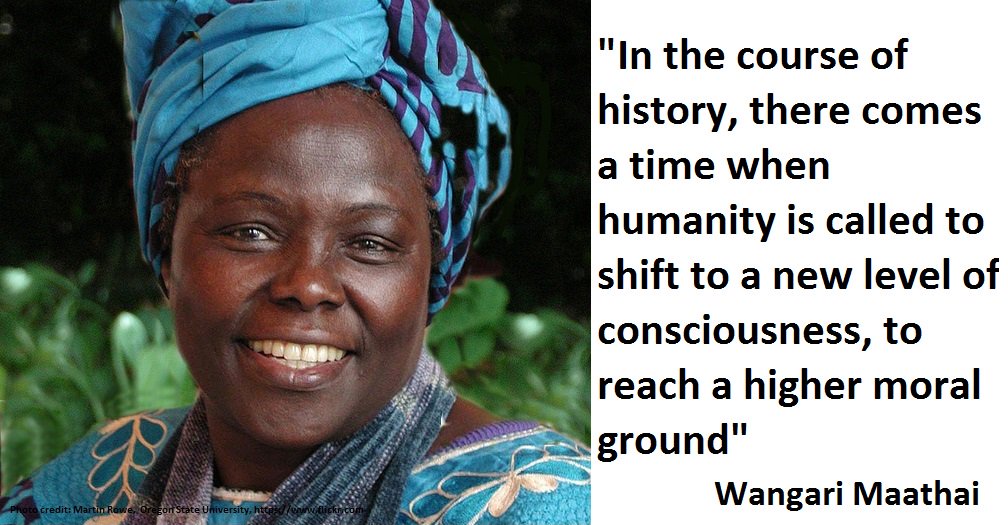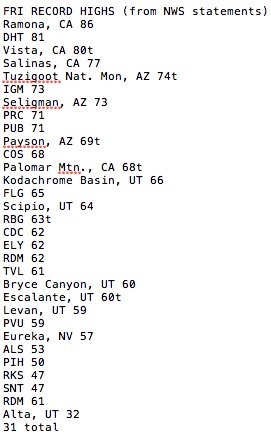Sunday December 31st… Dear Diary. Here is today’s climate change related topic:
Time for Those New Years Resolutions
Personally I’m going to pledge to make this site better for all to be more informed about how the issue of climate change is evolving. Today I’m scouring social media to post more eco-friendly resolutions. Here is the first:

1. @christianenviro for the best #environment quotes
2. @KHayhoe for dispelling #climate denying myths
3. @franifio for sassy news comedy keeping me #woke
4. @JerryBrownGov for stepping up on #climatechange
5. @water_days for updates on water

Oh yes!
 Mike HudemaVerified account @MikeHudema
Mike HudemaVerified account @MikeHudema

………………………………………………………………………………………………………………..
Ryan Maue continues to post some great graphics where records will be occurring. In this case we will see an extensive area of record low maximums to bring in the new year. As he suggests you may not want to go out and brave the elements . Brrr!

 NWS New York NYVerified account @NWSNewYorkNY
NWS New York NYVerified account @NWSNewYorkNY

The “cold team” is going to get off to a good start in 2018 since many record lows should be set east and north of the Southwest on January 1st:

Here is more on Monday morning from Ryan Maue:
Across Lower 48, average low temperature will be only 8°F
89% below freezing
36% below 0°F


Well, in the long run the cold team certainly did not win the game for 2017:

I’ll continue to post more relevant information as it crosses my radar during the day.
Dear Diary: Here are a couple of record maxes from today, the last day of 2017:
 Ryan Maue | weather.usVerified account @RyanMaue
Ryan Maue | weather.usVerified account @RyanMaue
Happy New Year 2018!
The Climate Guy
……………………………………………………………………………………………………………………………………………………………….
Saturday December 30th… Dear Diary. Here is today’s climate change related topic:
My Top Ten Climate Change Items For 2017
This list is a little different from those you might have seen on other outlets. I’m going to emphasize items that have longer term ramifications rather than shorter more weather related occurrences from this year. Let’s hope for a more positive list at the end of 2018. Good riddance to 2017!
1) Measurements of carbon in the atmosphere cross the 410 parts per million threshold. After the rate of carbon pollution leveled off from 2014-2016 unfortunately there was an uptick in 2017. This item is number one on my list since CO2 pollution ultimately influences the rest.
2) Global unanimity on how to tackle climate change, mainly because of the U.S., was not achieved. We all know what Trump did to the Paris accord this year not leading the planet towards green solutions. This item is number two because items 3-10 should diminish in future decades once global solutions come into play.
3) Global temperature averages are likely to come in at third warmest behind 2016 and 2015 with no sign of being curtailed in future years. The global warmth exacerbates items 4-10.
4) Arctic sea ice continues to destabilize, particularly in the Chukchi Sea with polar vortex weather ramifications. As the northern Hemisphere ice albedo diminishes we are starting to see changes in jet stream patterns, such as seeing a “Ridiculous Resilient Ridge” affecting items 6-10.
5) Researchers find that Antarctic glaciers are more unstable than once thought leading to higher sea level projections. This is item five on my list since global coastal areas will have less time to adapt as we move through the 21st century.
6) Due to warming SSTs hurricanes like Irma continue to become bigger and badder. Like near record warm atmospheric temperatures those of the ocean are definitely affecting tropical cyclones. Meteorologists noticed mega warmth in the Atlantic Basin during 2017. This item is greatly affecting what we are seeing in association with item number ten.
7) The Southwest, in particular California, is now susceptible to wild fires every month of the year. The Thomas fire in December was a big marker for climate change.
8) On a positive note green energy prices are at record lows to compete with carbon based energy. This item only comes in at number eight since item number one remains out of control.
9) Heat waves like those from the Southwest U.S. and Mediterranean continued to pop up across the planet. This item comes in at number nine for 2017 since at least we didn’t see a mega heat wave over North America or a widespread heat wave over northern and central Eurasia.
10) Poor people, like some Puerto Ricans from Maria, suffered more at the hands of climate change straining society creating many climate refugees during 2017. In prior years we saw as a partial result of induced drought from global warming Syrian refugees enter Europe. Now millions of Puerto Ricans want to leave their island home. Also, the social safety net was strained in southeast Texas from Harvey. I could easily rank this tem as high as number seven. Drop me a note if you think I should make some adjustments.
…………………………………………………………………………………………………….
Now let’s look at more record temperature reports. Here is an interesting note from TWC’s Jon Erdman:


It’s interesting as 2017 ends that many more record high tallies are being added to that “record scoreboard” despite the “mega” cold wather pattern in the East. The Southeest area is affected yet again this year by record warmth:


From today:
 NWS San DiegoVerified account @NWSSanDiego
NWS San DiegoVerified account @NWSSanDiego
78 F set in 1998 and 2011.
#SanDiegoWX #CAwx
I’m certain that the brutal weather pattern in the East will produce a fair share of records, though. Here’s a note from Ryan Maue:


We should see some record reports coming from the Upper Midwest for Sunday, the last day of 2017:

I’ll add more record data today to this post as it crosses my radar.
The Climate Guy
………………………………………………………………………………………………………………………….
Friday December 29th… Dear diary. Here is today’s climate change related topic:
Happens Nearly Every Winter.. Climate Change Doubters Point to Cold Weather Every Winter Part 2
Since the President of the United States jumped into the fray on this topic on Twitterland, sigh, I’ll present another well written piece on the subject here:
Quoting Dr. Marshall Shepherd from the article:
“The key thing to convey to that skeptical uncle or vociferous social media friend is that “weather is mood, climate is personality.” My University of Georgia colleague Dr. John Knox mentioned this a few years ago, and it has been one of my favorite techniques to use while dealing with this pesky climate communication challenge for the public. Weekly or daily weather patterns tell you nothing about longer-term climate change (and that goes for the warm days too). Climate is defined as the statistical properties of the atmosphere: averages, extremes, frequency of occurrence, deviations from normal, and so forth. The clothes that you have on today do not describe what you have in your closet but rather how you dressed for today’s weather. In reality, your closest is likely packed with coats, swimsuits, t-shirts, rain boots, and gloves. In other words, what’s in your closet is a representation of “climate.”
And remember…
 Kamala HarrisVerified account @KamalaHarris
Kamala HarrisVerified account @KamalaHarris
Climate change is real and it poses a grave threat to our nation and our planet. It’s abundantly clear this Adminstration won’t tackle climate change head on, so state and local governments must.
Let’s see if our President can read the tea leaves in association with this data, for example:
année 2017 record aussi dans la capitale #BuenosAires, la plus chaude depuis le début des mesures en 1906 avec une température moyenne de 18.7 ou 18.8°C battant les 18.6°C de l’année 2015. #climat #climate #Argentina
source : @SMN_Argentina >> http://www.smn.gob.ar/noticias/2017-r%C3%A9cord-de-temperatura-en-argentina …
#SMN_Argentina year 2017 also record in the capital #BuenosAires, the hottest since the start of the measurements in 1906 with an average temperature of 18.7 or 18.8 ° C beating the 18.6 ° C of the year 2015. #climat @climate http://www.smn.gob.ar/noticias/2017-r%C3%A9cord-de-temperatura-en-argentina … source: #SMN_Argentina > > @ttps://t.co/IgL7WSrSdj

Oh that’s right, he doesn’t understand French or Spanish.😉
…………………………………………………………………………………………………………………………
O.K. Enough fun for one day. Now let’s look at how well the “cold team” is putting a dent in the more than 10-1 ratios of daily high max records to daily min low records this month. For the 29th this miss was closer but no cigar:
 MDA Weather Services @MDA_Weather
MDA Weather Services @MDA_Weather
Andrew Freedman is presenting a running tally of records posted here:
In other words, it’s not just you — this cold snap is noteworthy, both for its severity and its duration. In many areas, it’s one of the sharpest cold waves to hit in between Christmas and New Years — period. Here are some of the cold temperature records that have been broken so far (H/T to weather.com for rounding up several of these records). This list will be updated throughout the event:
Dec. 29, 2017:
- Many locations in and around New York City set or tied record daily lows on Friday morning including Newark, LaGuardia, and JFK Airports, as well as Islip, Long Island, and Bridgeport, Connecticut.
Dec. 28, 2017:
- Boston set a record for the lowest maximum temperature for the date, with the high only reaching 12 degrees Fahrenheit. The previous record for the date was 18 degrees.
- Flint, Michigan set an all-time December record-low temperature of minus-18 degrees Fahrenheit on Thursday morning. This broke the existing all-time December low of minus-14, which was recorded the previous day. It’s possible that the new monthly record will fall again before this cold snap ends.
- Alpena, Michigan, reached a low temperature of minus-19 degrees Fahrenheit on Dec. 28. This was the second-coldest December temperature on record there.
- There were about 30 daily record lows set or tied in the lower 48 states on Thursday, including Watertown, New York, which hit minus-32 degrees Fahrenheit.
- Daily records were also set in Syracuse, New York City, Baltimore, and Boston, among other locations.
- Toronto, Ontario, reached minus-22 degrees Celsius, or minus-8 degrees Fahrenheit, on Thursday morning, which established a new daily record.
- Muskoka Airport, Ontario, set a record low temperature of minus-36.4 degrees Celsius, or minus-34 degrees Fahrenheit, beating the old record of minus-28.3 degrees Celsius, set in 1963.
- Montreal, Quebec, set a daily record low on Thursday, at minus-20.5 degrees Celsius, or minus-5 degrees Fahrenheit, beating the old record of minus-19.5 degrees, set in 1993.
Dec. 27, 2017:
- International Falls, Minnesota, known as the “nation’s icebox” set a daily record low on Wednesday when the actual air temperature reached minus-37 degrees Fahrenheit. This beat the previous daily record of minus-32 degrees.
- Embarrass and Cotton, Minnesota, were even colder that morning at minus-40 and minus-41 degrees Fahrenheit, respectively. However, those were not record lows for those locations, believe it or not.
- Lincoln, Nebraska, reached 17 below on Wednesday, setting a new daily record, and Norfolk, Nebraska set a daily record with minus-15 degrees.
I’ll add more relevant information as it crosses my radar later today.
The Climate Guy








